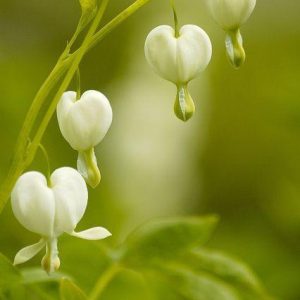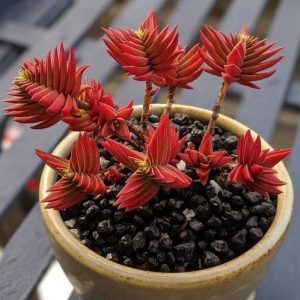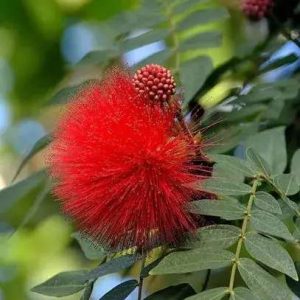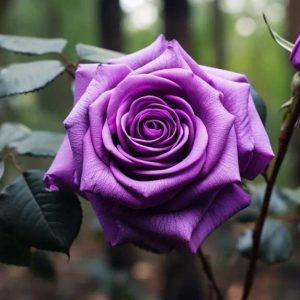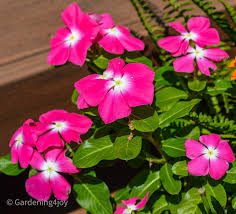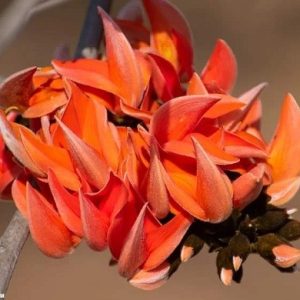Early spring perennials add the warmth of spring to your yard before the season arrives. Not only do these spring perennial flowers beautify your garden, but they also attract important pollinators, such as bees and butterflies. They also come back every spring, for at least a few growing seasons.
Picking the right type of flowers for your garden can be a challenge, with so many different options available. While there are many annual choices, it’s harder to find flowers that bloom early in the season, that will return the following year with minimal effort.
So, let’s get started by welcoming the spring season with your garden in full bloom. Here are 21 early blooming spring perennial flowers to delight your garden and kick the winter blues away. Let’s dive in a little deeper and take a look at our favorites!

Baptisia, also known as blue false indigo, is a native flowering plant that looks spectacular in full bloom. This hefty plant can reach up to four feet high and wide.
When spring arrives, Baptisia features sturdy spires of white, blue, yellow, or pink blooms, which are an excellent addition to any flower arrangement. It’s also drought tolerant and requires very little maintenance to blossom for years.
Baptisia is used as seasonal and ornamental shrubs. It’s excellent in native gardens, traditional cottages, and contemporary areas. The shape and vibrant colors contrast very well with the ornamental grasses.
This plant is also a host for larvae of various butterfly species, especially those feeding on many plant families.

Bearded Iris is a classic spring perennial that features crepe-paper petals and beautiful blooms. It’s one of the easiest and earliest spring perennials to grow. With care, it produces spearlike leaves and long stems with spectacular flowers in varying colors, such as orange, yellow, pink, blue, or white.
The plant prefers well-drained soil with at least six hours of sun exposure daily to thrive. Many people think these flowers are some type of rare orchid variety, but they are not actually related in any way.

Bergenia is a versatile perennial plant that thrives both in sun and shade. So, if you have some shady portions in your garden that need awakening, then this plant might be the one for you.
It’s also known as pig squeak because of the sound it makes when you rub its two leaves together. This plant can fill that shady spot in your yard with blooming flowers.
While this plant is large and vigorous, it’s not invasive. Instead, it creeps slowly, forming a ground cover in your garden. It’s also very low-maintenance and can grow in any soil type.
However, experts suggest planning them in well-drained soil with a high amount of humus. It also needs a little care to enhance its look, such as cutting off dead leaves and deadheads after the flowers fade.

Bleeding heart is one of the spring perennial flowers which adorns the garden with its heart-shaped blooms. It’s an old-fashioned plant also known as Dicentra eximia. Even its fernlike leaves are very attractive. When it comes to color, this perennial flower comes in shades of red, and pink.
Growing the plant is pretty simple. Once you understand how easy it is to grow it, you surely want to use it to add life to your garden’s dark and shady spots.
While the bleeding heart is a spectacular sight, once the bloom fades, it goes dormant until the next spring. So, don’t let it stop you from having this plant in your garden. It’s recommended to plant it near a later-emerging plant which can fill in the voids.

Bloodroot is also an early spring bloomer found in the wild in wooded areas. It produces beautiful, attractive flowers with up to 12 petals blooming on leafless stems.
The plant got its name from the dark-red sap, which can be found throughout it, resembling blood. The juice produced by the plant’s stems is used to make dyes.
When handling this plant and practicing plant care, gloves are essential to protect your skin from irritants. In the past, the plant was used as traditional medicine. However, research shows that all parts of Bloodroot are toxic to mammals. Thus, it’s necessary to let professionals extract the powder and juices from the plant.
Bloodroot is currently being studied as a potential treatment for skin cancer, though this plant is now hard to find in the U.S. Additionally, bloodroot products are more expensive because of the scarcity of supply.

Creeping phlox is a low-growing perennial flowering plant used as a ground cover and in rock gardens. The plant features vibrant, fragrant flowers with varying colors, such as red, purple, and pink, making it a desirable addition to any landscape. This perennial is also available in white, making it a great choice to balance out brightly colored garden spaces.
The plant can grow up to six inches high and two feet wide. It produces long stems that get woody as the plant matures.
The thicker growth stops the plant from blooming, but it can be cut out to encourage new branches to produce flowers again. The plant needs very little maintenance, and it’s also deer-resistant and trouble-free.

Cushion spurge is among the thousand spurge species which is known for its beautiful, vibrant spring colors, especially yellow. This yellow perennial flower is a great option for gardeners that need a splash of color to liven up their garden space. It’s a herbaceous flowering plant growing in a cushion shape paired with spring bulbs like tulips as ground cover in the garden.
Similar to poinsettia, its sibling, the color of cushion spurge doesn’t come from its beautiful blooms but from its pale green leaves called bracts surrounding the flowers.
The plant grows in a mound and can reach up to a foot high. It can also thrive in full shade and full sun, which isn’t a common trait in early spring perennials.
The plant produces a mound of foliage about a foot in height and thrives in everything from full sun to full shade. That’s not an overly common trait among early blooming perennials. The plant also prefers well-drained and slightly dry soil.

Echinacea is a group of herbaceous flowering plants, commonly known as coneflowers. It grows well in open wooded areas and dry prairies. This sturdy plant blooms daisy-like flowers that magnet bees, butterflies, and birds to your garden.
Usually, the flowers come in white or pinkish-purple colors. However, the hybrids produce blooms in rainbow colors, such as orange, yellow, cream, and burgundy.
The plant is almost disease and pest-free, and it produces long-lasting cut flowers. So, if you want to have bees, butterflies, and birds in your garden, planting coneflower is definitely the way to go.
Interestingly, coneflower has been used as herbal medicine for centuries. Research shows that it improves immunity, anxiety, blood sugar, and skin health.

If you want a plant that blooms for a long time, then the Golden Alexander is for you. It can surely give your garden some well-deserved colors for weeks. The plant features sunny yellow blooms with large, heart-shaped leaves that grow up to three inches high and wide.
This tough, sturdy plant is native to North America, and it needs to grow in lean soil and partial to full sun. The plant is also essential to several short-tongued insects that can reach the nectars easily. Additionally, caterpillars also feed on the plant’s leaves.

Grecian windflower is a spring perennial that produces beautiful daisy-like flowers. This short-growing flowering plant can reach up to six inches high and act as a ground cover in gardens. Many grow this plant in low rows complementing other taller perennials.
The Grecian windflower has several varieties with varying colors, such as white, pink, blue, lavender, mauve, and magenta. The plant blooms for up to six weeks, and its medium green foliage remains for another eight weeks at maximum.
With proper care and maintenance, the plant gets a proliferation of flowers in early spring. Usually, the Grecian windflower is among the first perennials to produce flowers after winter.

Nepeta is a group of spring perennials that include various cultivars that are grown for their spikes of violet and blue flowers. Also known as catmint, the plant starts to bloom in early spring throughout the summer. It features purplish-blue flowers and soft gray-green foliage.
This plant is multipurpose, which means there’s a type of Nepeta for every landscape. You can find short varieties of Nepeta, which are perfect as edging plants, and there are also taller types that are excellent as flower borders.
The plant prefers well-drained soil and full sun to light shade. It’s also very tolerant to heat and drought, and the minty leaves make the plant deer and rabbit-resistant. Additionally, it attracts bees, butterflies, and other insects.

Despite the name, the lenten rose isn’t a rose but rather a hellebore hybrid. It’s also a spring perennial that got its name from its rose-like blooms. Additionally, it’s very easy to grow in the garden, making it a great addition to add a splash of colors to some dark, shady spots.
The plant is a slow grower. It takes about three years before it matures and blooms. But when it blooms, the garden is filled with varying colors of white, pink, red, and purple, appearing at or below the leaves.
Once the bloom fades, you can still enjoy its attractive evergreen, umbrella-like foliage.
Lenten rose prefers a well-drained soil that is consistently kept moist and mulch. It can also thrive in partial to full shade.

The lungwort flower got its name from its lung-shaped leaves, which practitioners believed to cure lung disorders long ago. Other names for lungwort are Jerusalem cowslip, Bethlehem sage, soldiers and sailors, and spotted dogs.
Typically, the plant is grown for its attractive foliage available in different varieties. Most varieties have elliptic-shaped leaves with random white or silver spots. Newer varieties have white or silver leaves with random green spots.
The flowers can come in more than one color on a single plant. Usually, the flower starts out one color and fades into another as the flower matures.
Lungwort grows well in moist, well-drained soil and partial shade. It’s also a low-maintenance plant that you only need to water in times of drought.

Marsh marigold is an early spring perennial in the buttercup family. This plant isn’t related to the traditional marigolds and is also not a traditional herb. The parts of this plant, such as the leaves and buds, are toxic unless they are adequately cooked.
Traditionally, the yellow oil produced by the plant was used to give color to butter, which is a favorite of grazing cows. However, the horses and cattle that consumed marsh marigolds were poisoned.
This attractive plant is used in gardens and landscapes. It’s an excellent addition to the garden because it magnets bees, butterflies, and hummingbirds.

Peony is one of the most-loved early spring perennials in the genus Paeonia. This bushy plant is outrageously attractive because it produces the fattest and big round, fragrant flowers and perfect lush green foliage.
It offers various types of flowers that include:
- Single
- Semi-double
- Full double
- Anemone
- Bombe
- Japanese
Most peonies produce white or pink blooms, but you can also find red, purple, yellow, and orange. You can plant peonies in the ground as late as October.
Peony can grow pretty large, and its heavy top can offer shelter from strong winds. So, don’t grow it near trees to avoid competition for food, light, and soil nutrients.
The plant prefers well-drained and fertile soil that has high humus content. It requires little care and is known as a long-lived plant that blooms healthily for decades.

Primrose is an early spring perennial that is excellent to plant around water features, as it does well in moist environments. It also offers many varieties with different colors, sizes, and forms.
Many use primrose as ornaments in garden beds and borders. It’s also suitable for pots and naturalizing areas of the garden.
One of the most common primrose species is the Polyanthus hybrid, with flower colors ranging from white, pink, red, yellow, and orange. You can also find purplish-blue flowers in other areas.
It’s very easy to grow this plant because it’s hardy and adaptable. When given proper care and maintenance, this beautiful plant continues to multiply annually and consistently adds spectacular colors to your garden.
Blooms start in early spring and usually last throughout summer. The plant will delight the garden with its stunning colors until the fall season in other areas.

Russian sage is definitely a head-turner with its haze of lavender or purplish-blue flowers atop silvery foliage. This large, shrubby early spring perennial provides vibrant colors when you need it the most. You can plant Russian sage in drifts if you want more intense colors.
Additionally, close planting prevents staking since taller plants can flop down.
When you crush the leaves of Russian sage, they become aromatic like the members of the mint family. It also has several varieties found on the market. Some varieties can grow up to five feet high and four feet wide.
Other smaller species, like the Little Spire, can reach only up to 24 inches high and wide.
This plant requires little care. It’s nearly heat and drought tolerance once the root systems are established. Plus, the plant requires water until the roots get the chance to reach adequate depth into the soil.
It’s necessary to water the plant during the first growing season to establish the root system.

Brunnera is one of the prettiest early spring perennials to add to your shady garden. Siberian Bugloss is one cultivar of the Brunnera plant, which many varieties that feature various foliage colors used as a groundcover.
One of the most popular cultivars is the Jack Frost (also known as Siberian Bugloss), which got its name from its leaves with varying white, silver, and gray hues.
Brunnera can thrive in part to full shade. It’s also essential to grow it in well-drained soil to keep light moisture consistently. The plant doesn’t do well in dry soil, neither will it thrive in soggy soil.
Brunnera is easy to care for. Plant care includes watering to keep the moisture in the soil and provide drainage to ensure that the roots won’t sit in soggy soil. The plant can reach up to 2 feet high and wide and grow in small mounds.

Twinleaf is an herbaceous spring perennial native to North America. It’s often mistaken for the Bloodroot plant because of the similarities in their flowers. Even more remarkable about its flowers is that they continue to bloom even before the leaves spread apart.
The plant has a botanical name called Jeffersonia diphylla, named after Thomas Jefferson, who grew it. Its common name was derived from the plant’s twin leaves shaped like butterfly wings. The plant does well in moist, well-drained loam with high humus content.

Viola is a beautiful spring perennial that comes back annually. There are over 500 different species in the Viola genus. This short-lived perennial is a smaller cousin of pansy, offering tiny flowers that bloom in varying colors, such as yellow, white, blue, and purple. It can thrive in containers and window boxes as long as it’s regularly watered.
Additionally, the flowers are edible, which can be added to salads and other desserts. The flowers also have medicinal properties which can ease inflammations, irritation, and swelling.

Virginia bluebell is an excellent addition to your spring garden. This native early spring perennial deserves a spot in every yard. This plant is self-seeding, which means it can spread rapidly and be considered invasive.
The plant features smooth, oval-shaped, purple leaves and trumpet-shaped flowers changing from pink to blue as they bloom. It grows well in rich, moist soil and partial to full shade.
If you want a colorful garden that looks spectacular from spring to winter, then plant any of these early spring perennials with varying bloom times. All of these perennials are easy to grow and care for and will come back annually to add colors and vibrance to your garden. If you can’t find the perfect perennial for your garden, you can always check out some annual flowers that will bloom all season instead. Just be prepared to replant them each season.
